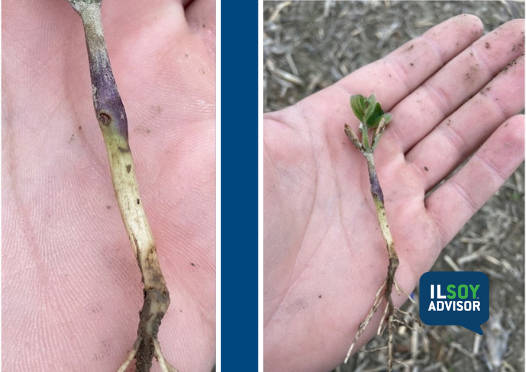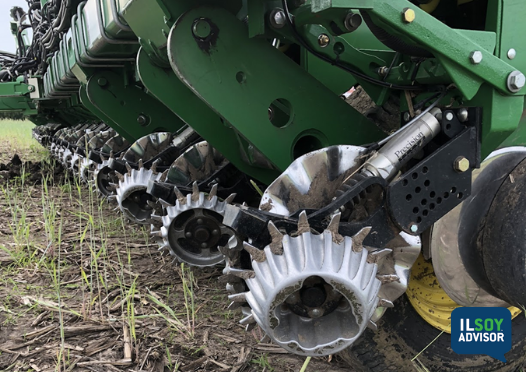ILSOYADVISOR POST
Late Planting Decisions in 2019
This article was originally published on the farmdoc daily website.
Schnitkey, G. and C. Zulauf. "Late Planting Decisions in 2019." farmdoc daily (9):83, Department of Agricultural and Consumer Economics, University of Illinois at Urbana-Champaign, May 7, 2019.
Planting over much of the Midwest is seriously delayed. History suggests the odds have also increased for lower corn yields in 2019 than in 2018 (farmdoc daily, May 1, 2019), and soybean yields likely will not be exceptional. Lower yields then potentially lead to very low net incomes. The typical switching from corn to soybean decisions are complicated because of low soybean prices. Prevented planting could come into play on many farms.
Late Planting 2019
Very little planting has occurred over much of the Corn Belt. According to the May 6th Crop Progress report, 23% of the acres were planted in the 18 largest corn-producing states, compared to a 46% average for the last five years. Low percentages exist in all greater Corn Belt states:
- North Dakota: 3% in 2018 compared to a 23% five-year average,
- South Dakota: 0% compared to 29% five-year average,
- Nebraska: 35% compared to a 47% five-year average,
- Kansas: 36% compared to a 51% five-year average,
- Minnesota: 6% compared to a 42 five-year average,
- Iowa: 36% compared to a 51% five-year average,
- Missouri: 49% compared to a 74% five-year average,
- Wisconsin: 7% compared to a 24% five-year average,
- Illinois: 10% compared to a 66% five-year average,
- Indiana: 3% compared to a 35% five-year average,
- Michigan: 3% compared to a 16% five-year average, and
- Ohio: 2% compared to a 27% five-year average.
Rains are projected for this week, likely further limiting planting progress.
Likelihood of Lower Yields
Perhaps the largest impact of late planting will be on 2019 yields. In the past six years, yields have been exceptional across Illinois in particular and the Midwest generally (see farmdoc daily, September 5, 2018). The higher 2018 yields kept net incomes high enough such that serious declines in liquidity did not occur on many farms. Very low incomes would result if yields are near trend, and there is not an increase in prices or another round of Market Facilitation Program (MFP) payments (farmdoc daily, January 15, 2019). Commodity program payments, either through Price Loss Coverage (PLC) or Agricultural Risk Coverage (ARC), likely will be important sources of revenue, particularly on soybeans.
Late planting does not necessarily mean that 2019 yields will be low. In 2009, much late planting of corn occurred and national yields were still 10 bushels above trend (farmdoc daily, May 1, 2019). Despite exceptions, higher percentages of late planting of corn typically lead to below trend yields (farmdoc daily, May 1, 2019). A good illustration of the impacts of late planting of corn due to wet weather occurred last year in northern Iowa and southern Minnesota. County yields near the Iowa-Minnesota border were below trend in 2018, both for corn and soybeans (see farmdoc daily, April 9, 2019).
Corn and Soybean Prices
As of yet, there has been no positive price response to late planting and, in fact, corn and soybean have declined in recent months. To illustrate, current Chicago Mercantile Exchange (CME) futures prices are below projected prices used to set crop insurance guarantees. For corn and soybeans in Midwest states, projected insurance prices are the average settlement prices of Chicago Mercantile Exchange (CME) contracts during the month of February. The December contract is used for corn and the November contract is used for soybeans. The 2019 projected corn price is $4.00 per bushel, while the May 6th settlement price is 4.5% lower at $3.82 per bushel. The 2019 projected price of soybeans is $9.54, while the May 6th settlement price is 11% lower at $8.50 per bushel. Soybean prices have declined more than corn. Current cash bids for fall delivery are near $8.00 for soybeans in central Illinois. Sub-$8.00 soybean prices are a real possibility come this fall.
While neither corn nor soybean prices are particularly attractive, soybeans prices appear to have more downside potential (farmdoc daily, May 6, 2019). The prospects of eliminating Chinese tariffs on U.S. soybeans appear to be diminishing. Even if tariffs are resolved, the presence of African Swine Fever (ASF) in China could reduce soybean demand. Both corn and soybean production in South America are higher in 2019 than in 2018 (WASDE, April 2019). The strengthening of the U.S. dollar relative to the Brazilian Real and Argentinian Peso further favors South America exports over U.S. exports. Furthermore, soybean prices could further decline if U.S. producers switch significant acres from corn to soybeans due to late planting conditions.
Corn versus Soybean Decisions
Weakening soybean prices complicates late planting decisions, making the typical switching decisions from corn to soybean more difficult. Table 1 shows break-even soybean yields for a $3.50 corn price and an $8.00 soybean price, the current bids for fall delivery in central Illinois. Break-even soybean yields are given for northern Illinois, central Illinois with high-productivity farmland (Central-High), central Illinois with low-productivity farmland (Central-Low), and southern Illinois. Although costs vary across these regions, break-even soybean levels do not vary much across the regions. At a 190 bushels corn yield, for example, the break-even soybean yields are 52 bushels per acre in the Central-low region and 55 bushels per acre in the other regions.
Continue reading the full article on farmdoc daily.





Comments
Add new comment